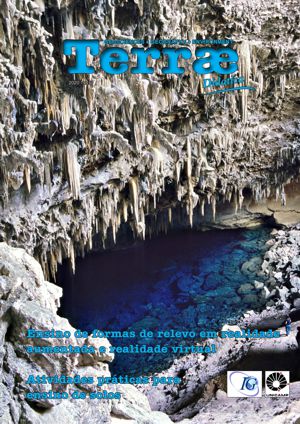Abstract
Gemology: the thousand colors science. The Gemology is the science that studies the gemological materials, which vary between emerald, amethyst, tourmaline, topaz, diamond, among many others. Brazil produces a large part of these varieties and, paradoxically, the Brazilian scientific gemology is still immature. Currently, new technologies improved production and gems treatment techniques of most of these minerals and, consequently, these new substances flooded the market. Alarming events related to technical miss concepts and trading motivated the author to produce this publication in order to disseminate basic concepts about Gemology. The lack of knowledge on the part of the professionals and gemology lovers can lead to disappointments and even financial losses for both parties. The objective is to educate and teach this science in a conscientious way, through simple experience and knowledge, which may provide greater autonomy for all audiences and present, to those tireless admirers of beautiful things, the enchanting universe of a thousand colors.
References
Atelier Márcia Pompei (2020). Curso Iniciação à Gemologia. São Paulo, SP. URL: https://www.ateliermarciapompei.com.br/cursos/iniciacao-a-gemologia/. Acesso 20.04.2020.
Barbosa, C. T. (2009). A cor do citrino: efeito de irradiação e tratamento térmico. (Trabalho Conclusão Curso). Rio Claro, Universidade Estadual de São Paulo, UNESP. 77p.
Canadian Institute of Gemmology (CIG). (2020). Accredited Gemmologist. Vancouver (CA). URL: https://www.cigem.ca/education/accredited-gemmologist. Acesso 20.04.2020.
Cornejo, C., & Bartorelli, A. (2010). Minerais e pedras preciosas do Brasil. São Paulo: Solaris Ed. Culturais. 704p. (ISBN 978-85-89820-09-7).
CIBJO. The World Jewellery Confederation. (2017). Blue books. URL: http://www.cibjo.org/introduction-to-the-blue-books-2/. Acesso 20.04.2020.
Federal Trade Commission (FTC). (2018). Guides for the Jewelry, Precious Metals, and Pewter Industries. URL: https://www.ftc.gov/public-statements/2018/07/statement-basis-purpose-final-revisions-jewelry-guides. Acesso 24.07.2018.
Gavrilenko, E. (2020). Gems inclusions. All about inclusion in gemstones. URL: https://www.gems-inclusions.com/#. Acesso 07.02.2020.
Gemmological Association of Great Britain. Gem-A. (s.d). Gemmology Diploma. London (UK). URL: https://gem-a.com/education/courses/gemmology. Acesso 20.04.2020.
Gemological Institute of America. GIA. (2020). GIA Education. Carlsbad (CA). URL: https://www.gia.edu/. Acesso 20.04.2020.
German Gemmological Association. DGemG. (s.d). Coloured Stones Programme. Idar-Oberstein (DE). URL: https://www.dgemg.com/en/. Acesso 20.04.2020.
Grew, E. S., Locock, A. J., Mills, S. J., Galuskina, I. O., Galuskin, E. V., & Hålenius, U. (2013). Nomenclature of the garnet supergroup. American Mineralogist, 98, p. 785-811. doi: 10.2138/am.2013.4201.
Gübelin, E. F., Koivula, J. I. (2004). Photoatlas of inclusions in gemstones. 4 ed. Gemological Institute of America. 532p. (ISBN: 978-38-55040-95-7).
Gübelin Gem Lab. (2020). Academy. Lucerne (CH). https://www.gubelingemlab.com/en/academy. Acesso 20.04.2020.
Henn, U., & Schultz-Güttler, R. (2012). Review of some current coloured quartz varieties. The Journal of Gemmology, 33 (1-4), 29-43.
Hanneman, W. W. (2011). Pragmatic Spectroscopy for Gemologists. 2 ed. Vancouver, Canadá, Hanneman Gemological Instruments. 64p.
Henry, D. J., Novák, M., Hawthorne, F. C., Ertl, A., Dutrow, B. L., Uher, P., & Pezzotta, F. (2011). Nomenclature of the tourmaline-supergroup minerals. American Mineralogist, 96, 895-913. doi: 10.2138/am.2011.3636.
International Mineralogical Association (IMA). (2020). List of Minerals. March 2020. URL: https://www.ima-mineralogy.org/Minlist.htm. Acesso 15.04.2020.
Johnston, C. W., Wyatt, M. A., Li, X., Ibrahim, A., Shuster, J., Southam, G., & Magarvey, N. A. (2013). Gold biomineralization by a metallophore from a gold-associated microbe. Nature Chemical Biology, 9, 241-243. doi: 10.1038/nchembio.1179.
Klein, C., & Dutrow, B. (2012). Manual de Ciência dos Minerais. Bookman, 23. ed. 716p. (ISBN: 978-85-7780-963-9).
Laboratório de Pesquisas Gemológicas (LAPEGE). (2020). Técnicas de identificação de Gemas: do básico ao avançado. Centro de Tecnologia Mineral (CETEM). Rio de Janeiro. URL: https://www.cetem.gov.br/lapege. Acesso 20.04.2020.
Nassau, K. (2001). The Physics and Chemistry of Color: The Fifteen Causes of Color. 2 ed. New York, Wiley-Blackwell. 504 p. (ISBN: 978-0-471-39106-7).
Nesse, W. D. (2016). Introduction to mineralogy. Oxford University Press. 3 ed. New York. 512p. (ISBN: 978-01-90618-35-3).
Munsell Color. (2020). Munsell’s theory of color. URL: https://munsell.com/about-munsell-color/. Acesso 28.04.2020.
Pasero, M., Kampf, A. R., Ferraris, C., Pekov, I. V., Rakovan, J., & White, T. J. (2010). Nomenclature of the apatite supergroup minerals. European Journal of Mineralogy, 22(2), 163-179. doi: 10.1127/0935-1221/2010/0022-2022.
Reith, F., Etschmann, B., Grosse, C., Moors, H., Benotmane, M. A., Monsieurs, P., Grass, G., Doonan,… & Brugger, J. (2009). Mechanisms of gold biomineralization in the bacterium Cupriavidus metallidurans. Proceedings of the National Academy of Sciences of the United States of America, 106(42), 17757-17762. doi: 10.1073/pnas.0904583106.
Schultz-Güttler, R., & Brusa, L. (2006). As cores nas gemas. Diamond News, 6(24), p. 6-8. (ISSN: 1678-4863)
Schumann, W. (2013). Gemstones of the world. 5 ed. New York: Sterling. 418p.
Swiss Gemmological Institute. SSEF. (2020). Basic Gemmology Course (BGC). URL: https://www.ssef.ch/courses/. Acesso 20.04.2020.
Terra, C. B. (2012). A origem do quartzo “green gold”: tratamento e ambiente geológico. (Dissertação de Mestrado). São Paulo, Universidade de São Paulo, USP. 132p.
Terra, C. B., & Schultz-Güttler, R. (2017). As variações de cores do quartzo green gold. In: Anais do I Simpósio Nacional de Ourivesaria e Design de Joias e IV Seminário de Gemologia, Belo Horizonte, 157-172. (ISBN: 978-85-62578-80-9).
Terra, C. B. (2019). Introdução à gemologia: minicurso. Editora: Cassandra Terra Barbosa. Ed. 1, Brasília, p. 117. (ISBN: 978-65-901692-0-4).
Université de Nantes. (2019). DUG Gemmologie. Nantes (FR). URL: https://sciences-techniques.univ-nantes.fr/formations/du-gemmologie-2020271.kjsp. Acesso 20.04.2020.
Universidade de São Paulo. (2020). Disciplina: GMG0425. Técnicas Gemológicas. São Paulo (SP). URL: https://uspdigital.usp.br/jupiterweb/obterDisciplina?sgldis=GMG0425&codcur=44011&codhab=100. Acesso 20.04.2020.
Universidade Federal de Belo Horizonte. (2020). Gemologia. Belo Horizonte (MG). URL: https://ufmg.br/cursos/pos-graduacao/mestrado/2546/02/90605/68448. Acesso 20.04.2020.
Universidade Federal do Espírito Santo. (2013). Curso de Gemologia. Vitória (ES). URL: http://www.gemologia.ufes.br/curriculo-do-curso-e-ppc. Acesso 20.04.2020.
Yanko, V., Arnold, A. J., & Parker, W.C. (1999). Effects of marine pollution on benthic Foraminifera. In: Modern Foraminifera. Dordrecht, Springer. p. 217-235. doi: 10.1007/0-306-48104-9_13.

This work is licensed under a Creative Commons Attribution-NonCommercial 4.0 International License.
Copyright (c) 2020 Terrae Didatica


